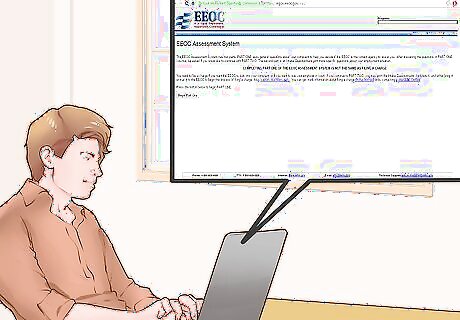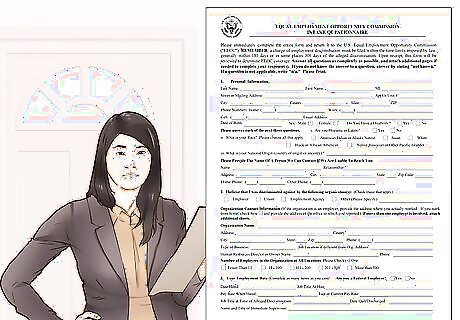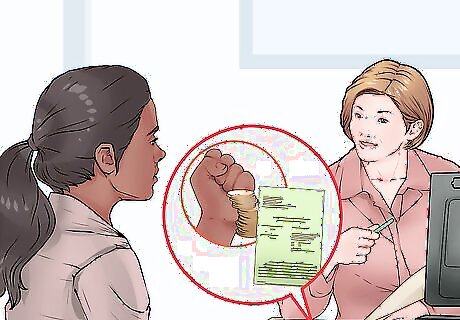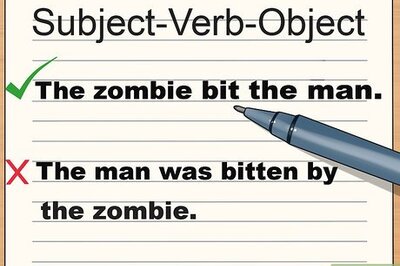
views
Assessing Your Eligibility to File a Charge

Evaluate whether you are still within the time limits for filing a charge. The federal deadline for filing a discrimination charge is 180 days from the time the act that is the basis of your charge occurred. If more than one act occurred, each act typically has its own deadline. However, if the situation is an ongoing pattern of harassment, the deadline applies to the last incident that occurred. If a state or local agency enforces a law that prohibits discrimination on the same basis, your deadline to file a federal charge is extended to 300 days. However, if you allege age discrimination, the deadline is only extended for state laws, not local ones. If you are a federal employee, or applied to work at a federal agency, and you believe you were discriminated against, you have a different deadline. You must contact an EEO Counselor at the agency where you work or where you applied to work within 45 days of the date the alleged discrimination occurred. From there, you typically will be given the option of participating in EEO counseling or going to mediation.

Figure out how many employees your employer has. Federal law only applies to employers who have a certain number of employees. Business and private employers are covered generally if they have 15 or more employees who have worked at least 20 calendar weeks in a year. For the purposes of age discrimination, the number of employees is increased to 20. State and local governments are subject to federal anti-discrimination laws if they employ at least 15 people who work at least 20 calendar weeks in a year. State and local governments are covered by the Equal Pay Act and by the laws prohibiting age discrimination regardless of the number of employees they have. All federal agencies are covered by the laws enforced by the EEOC regardless of how many employees they have. Employment agencies also are covered under the laws if they regularly refer employees to employers, no matter how many employees they have. Labor unions or apprentice committees are generally covered under federal anti-discrimination law if they have at least 15 members. The prohibition against age discrimination applies to unions that have at least 25 members. An employee is counted if she worked for the employer at least 20 calendar weeks in either this year or last year. In some cases, you may be allowed to count employees at multiple worksites together for the purpose of determining whether the employer is subject to federal anti-discrimination law. For example, if a shop owner owns three different surf shops that each employed 10 people, he may be covered by federal anti-discrimination laws.

Determine whether you would be considered an employee under federal law. The anti-discrimination laws only apply to employees, former employees, or those applying to be employees – they do not apply to independent contractors.
Filing a Discrimination Charge

Use the online assessment tool. Although the EEOC does not accept discrimination charges online, it does have an assessment tool that can help you confirm the EEOC has jurisdiction over your claim. Even if you've already analyzed whether you're eligible to file a charge with the EEOC, using the tool is a great way to double-check your work.

Complete the intake questionnaire. Once you know you're eligible to file a discrimination charge, your next step is to complete the official intake questionnaire. You also can mail a letter to the EEOC containing the same information that would be included on the official questionnaire. If you go this route, make sure your letter includes contact information both for you and for your employer, the number of employees working for your employer, and a short description of what took place and when, and why you believe those acts constitute discrimination. Sign your letter and mail it, and the EEOC will review it. The EEOC does not take charges over the phone, but you also can call 1-800-669-4000 if you need more information or have any questions about your charge or about the questionnaire. If necessary, the staff member on the phone will forward your questions or information to your nearest field office for evaluation.

Locate the nearest EEOC office. The EEOC has a map on its website that lists the location of each of the 53 field offices. Although you can file your charge at any of them, it probably would be best to use the one nearest you or your employer since that is more than likely the office that will review or investigate your charge.

File your discrimination charge. You may file your charge in person at the EEOC field office nearest you. However, if the office is too far away you can also mail your completed intake questionnaire to that office. If you are getting close to the deadline to file, call the office ahead of time and they will help guide you through the process.

Answer any questions or supply additional information requested by the EEOC. If you file in person, you will be interviewed by an EEOC employee regarding your claim. If you mail your questionnaire, you also may be interviewed over the phone, or you may receive a list of questions or requests for additional information in the mail. Once the EEOC employee assigned to your charge has all the information she needs, she will make a determination whether to forward it to an investigator or recommend you and your employer for mediation.
Understanding Federal Anti-Discrimination Laws

Recognize the types of discrimination prohibited under federal law. The EEOC enforces more than a half-dozen federal laws that make it illegal for employers to discriminate against you because of your race, color, religion, sex, national origin, age, disability, or genetic information. These laws protect you from being harassed or treated unfairly because of one of those reasons. They also forbid employers from retaliating against you if you complain about discrimination or assist with someone else's discrimination complaint or lawsuit. Federal law also requires employers to provide reasonable accommodation employees might need in the workplace because of their disability or religious beliefs.

Learn what actions constitute discrimination. The laws enforced by the EEOC forbid discrimination in every aspect of employment, from the advertisement of an available job all the way through termination. However, just because you are a member of a racial minority, for example, doesn't mean that any adverse action that happens to you in the workplace is an act of discrimination. The laws simply forbid your employer from taking adverse action against you because of your race. Job applicants may be discriminated against in that a covered employer could not, for example, post a "help wanted" ad for a secretary saying that only beautiful young blonde females should apply. This probably would constitute not only gender and age discrimination (because it discourages men and older people from applying), but potentially racial discrimination as well (because it was limited to women with blonde hair). Employers are forbidden to take things such as race, sex, or religion into account when referring employees for another position, making decisions about job assignments, promotions, or scheduling, or paying wages or benefits. Employers also cannot discipline, demote or discharge an employee for one of the protected reasons. For example, if a factory manager needs to lay off 50 employees, he can't choose to lay off the oldest employees first simply because of their age.

Review how the EEOC handles discrimination charges. If you understand a little about the EEOC's procedures before you file your charge you can make sure you have all the necessary information and aren't caught off guard. Within 10 days of receipt of your discrimination charge, the EEOC will send notice and a copy of your charge to your employer. The EEOC may send you and your employer to mediation to attempt to resolve the claim, or it may assign your charge to an investigator and ask your employer for a written answer. How long an investigation may last depends on how complicated the charge is and how much information must be gathered. However, if you're able to reach a resolution in mediation the matter usually can be settled within three months. After the investigation, if the EEOC finds no violation you will receive a notice that gives you permission to file a lawsuit. If the EEOC finds a violation but cannot reach a settlement with your employer, your charge will be sent over to the agency's legal staff. If the legal staff decide not to sue on your behalf, you'll receive a notice that gives you permission to file a lawsuit yourself.

Find out what remedies are available for discrimination. If the EEOC finds discrimination, the agency aims to put you in the same position you would have been had the discrimination never happened. The specific type of relief available depends on the discriminatory action taken and its affect on you. For example, if your employer passed you over for a promotion because of your race, you may be entitled to placement in that position, to backpay or benefits you would have had if you had received the promotion, and any costs you incurred pursuing your discrimination charge. Monetary damages, which include compensation for out-of-pocket expenses and emotional pain suffered, and punitive damages intended to punish an employer for acting especially maliciously, are capped by federal law. For example, if an employer has 100 employees or fewer, compensatory and punitive damages combined cannot be more than $50,000.



















Comments
0 comment